
Samuel Kraemer (1857–1937) was a rancher, farmer, and businessman who is credited with much of the development of Anaheim, California during the 1920s.

The Ríos-Caledonia Adobe is a historic adobe house in San Miguel, California. Built in 1835 by Petronilo Ríos, the adobe is a California Historical Landmark. Today, the Ríos-Caledonia Adobe is open to the public as a house museum and library.
Downtown Anaheim, also known as Anaheim Colony Historic District, and as Anaheim Historic Center, is a neighborhood that serves as the administrative and historic center of the city of Anaheim, California. It is delimited by East, West, North, and South streets, and the main roads within it are Anaheim Boulevard, and Center Street.

The Singer Building in Pasadena, California is a Spanish Colonial Revival building located at 520 E. Colorado Boulevard in Pasadena, California. Built in 1926, the building was designed by Everett Phipps Babcock and is his only surviving non-residential design. The Spanish Colonial Revival design of the building was popular in Pasadena in the 1920s. Prominent features of the building's design include a red tile roof, a stone frieze with a tiled pattern, and piers with decorative moldings. The building originally housed a Singer Sewing Machine Company showroom and has since been used for other commercial purposes.
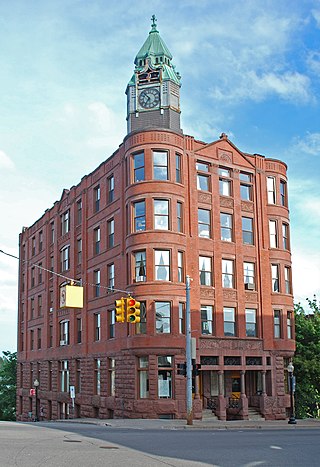
The Savings Bank Building is a commercial building located at 101 South Front Street in Marquette, Michigan. It is also known as the Marquette County Savings Bank. The building was designated a Michigan State Historic Site in 1976 and listed on the National Register of Historic Places in 1978.

The First National Bank Building is a historic building located in downtown Davenport, Iowa, United States. It was individually listed on the National Register of Historic Places in 1983. In 2020 it was included as a contributing property in the Davenport Downtown Commercial Historic District. The building is now known as the US Bank Building, its main tenant.

The Fullerton Odd Fellows Temple, also known as IOOF Building or Independent Order of Odd Fellows Lodge No.103 or Williams Building, is located in Fullerton, Orange County, California. It was designed by Oliver S. Compton-Hall and built during 1927-28 for the Independent Order of Odd Fellows Lodge Number 103, which existed from 1901 to 1981.
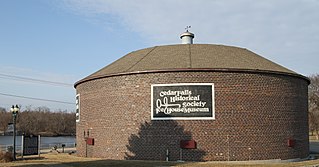
The Cedar Falls Ice House is a historic building located in Cedar Falls, Iowa, United States. It was built in 1921 and has been listed on the National Register of Historic Places since 1977. The building currently serves as the Ice House Museum.

The Union Arcade is an apartment building located in downtown Davenport, Iowa, United States. The building was individually listed on the National Register of Historic Places in 1983 by its original name Union Savings Bank and Trust. Originally, the building was built to house a bank and other professional offices. Although it was not the city's largest bank, and it was not in existence all that long, the building is still associated with Davenport's financial prosperity between 1900 and 1930. From 2014 to 2015 the building was renovated into apartments and it is now known as Union Arcade Apartments. In 2020 it was included as a contributing property in the Davenport Downtown Commercial Historic District.

The Carnegie Library in Anaheim, California is a Carnegie library building built in 1908. The Classical Revival style building was designed by John C. Austin, and opened in 1909.

Irvine Park is a 495-acre (200 ha) park in Orange, California. It became California's first regional park in 1897. When first opened, it was called Orange County Park, and was originally 160 acres which were gifted by James Irvine, the park's namesake.
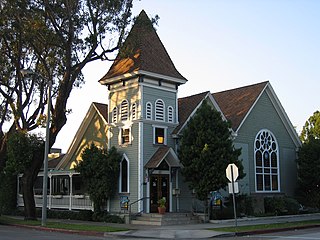
The First Baptist Church of Orange is a historic Baptist church building at 192 S. Orange Street in Orange, California. The building is currently owned by Avila's El Ranchito, a Mexican restaurant chain based in Orange County.

The St. Michael's Episcopal Church in Anaheim, California, also known as The Chapel at St. Michael's Episcopal Church, is a historic church at 311 West South Street. It was built in 1876 and was added to the National Register of Historic Places in 2004.

The New Hampshire Savings Bank Building is a historic commercial building at 97 North Main Street in downtown Concord, New Hampshire, across Capitol Street from the New Hampshire State House. The five story granite building was built in 1926-27 for what is now the oldest bank in the city, and was the only bank building built in the city in the first half of the 20th century. The building was listed on the National Register of Historic Places in 1988.

Farmers and Merchants Savings Bank, also known as Union Savings Bank and First Trust and Savings Bank, is an historic building located in Grand Mound, Iowa, United States. It was listed on the National Register of Historic Places in 2001.

The Woelke-Stoffel House is a two-story Queen Anne style home built in 1896, in Anaheim, Orange County, in Southern California. It was constructed by architects George Franklin Barber and Armstrong Davis Porter. The home is now owned by the City of Anaheim and part of Founders Park, in which sits a collection of historical buildings and acts as a museum. Free public tours are available on the 3rd Saturday of every month. Its location with close proximity to the Disneyland Resort makes it a popular tourist destination in the area. It was listed on the National Register of Historic Places on July 8, 2013. The house is in the Anaheim Founders' Park. Founders' Park also has the Pioneer House of the Mother Colony house built by the city's founder George Hanson. At the park is also a city landmark 1876 Moreton Bay Fig tree, a large Carriage House in Queen Anne style, vegetable garden, small orange grove, a Pump House and windmill.

The City Hall Park Historic District encompasses one of the central economic, civic, and public spaces of the city of Burlington, Vermont. Centered on City Hall Park, the area's architecture encapsulates the city's development from a frontier town to an urban commercial center. The district was listed on the National Register of Historic Places in 1983.

The New Center Commercial Historic District is a commercial historic district located on Woodward Avenue between Baltimore Street and Grand Boulevard in Detroit, Michigan. It was listed on the National Register of Historic Places in 2016.
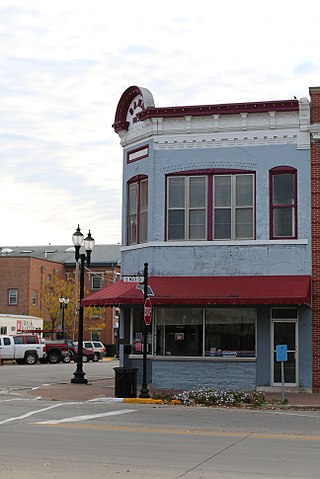
Henry County Savings Bank is a historic building located in Mount Pleasant, Iowa, United States. Because this two story, brick Italianate structure was built specifically as a bank, it features a chamfered corner, which was commonly used to designate a bank in the last quarter of the 19th century. Other features typical of an Italianate commercial building include segmental arched windows, a corbeled brick frieze, and a bracketed metal cornice. The building was listed on the National Register of Historic Places in 1991.
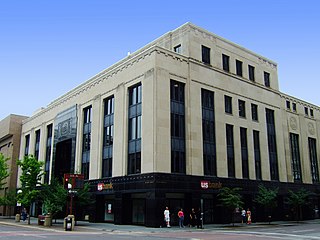
The Iowa-Des Moines National Bank Building, also known as the Valley National Bank Building and U.S. Bank, is a historic building located in downtown Des Moines, Iowa, United States. Designed by the prominent Des Moines architectural firm of Proudfoot, Rawson, Souers & Thomas, it was designed to be a 21- or 22-story building. It is one of the few downtown commercial buildings built in the Art Deco style. It is also thought to be one of the first bank buildings to put the banking room on the second floor while placing retail space on the first floor. Given its location in an area dominated by retail this made sense. This location had a bank on it since 1882 when the Des Moines National Bank built here. The present building was the result when Des Moines National Bank merged with Iowa National Bank and Des Moines Savings Bank and Trust Company in 1929. The original design for the building was a five-story base and a set-back rental office tower on top of it. The base was begun in 1931 and completed a year later. The building is composed of black polished granite on the first floor and the upper floors are Bedford stone. There is a recessed entrance in the center bay of the main facade. The fifth floor was meant to be the base of the office tower that was never built.























